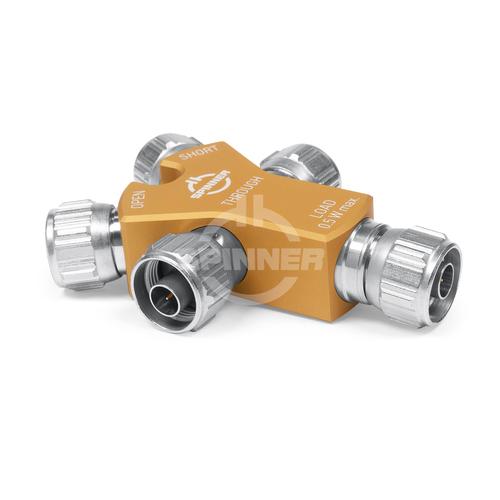Compact Calibration Kits - all necessary calibration standards in one handy unit
Nowadays, no development, production, testing, or quality control department that deals with RF signals on coaxial lines can afford to dispense with state-of-the-art high-precision equipment. It’s essential to use vector network analyzers (VNAs) in particular with high-precision connectors, terminations, and adapters.
Systematic errors can be fixed by calibrating the VNA. Different calibration standards with defined and known electrical characteristics are applied and compared to identify error coefficients. A technique called vector error correction is used to characterize error terms while applying known standards in order to remove errors from actual measurements and increase the accuracy of the results.
A VNA can be calibrated in different ways depending on the required degree of accuracy. The methods used differ in both the number and the type of the calibration standards applied.
The most commonly used calibration approaches are OSL (which stands for open-short-load) for single-port measurements and OSLT (for open-short-load-through) for multiple-port measurements. The order of the standards can vary in the designation; for example, the abbreviation SOLT is occasionally used synonymously.
4-in-1 compact calibration kits are used worldwide for the development of RF components for mobile communication, broadcast, radar applications, satellite communication, automotive engineering and manufacturing, mechanical engineering and many other industrial applications.
The OSLT compact calibration kit (4-in-1) DC-3 GHz N male (75 Ω) offers the combination of all necessary calibration standards in one handy unit. It is the optimal and easy solution for a convenient and complete calibration of a network analyser with two or more ports using the OSLT procedure with the calibration standards open circuits (O, open), short circuits (S, short), fixed loads (L, load) and through adapters (T, thru). The excellent handling, the ergonomic arrangement of the interfaces, the small design and the low weight are highly appreciated by the users.
The OSLT compact calibration kit (4-in-1) DC-3 GHz N male (75 Ω) has a characteristic impedance of 75 Ω. It is characterised by very low VSWR and attenuation values as well as best intermodulation properties in the entire operating frequency range from DC to 3 GHz. The test kit has 5 interfaces with N male.
The housing has a characteristic golden color in contrast to 50 Ω kits for easy visual differentiation.
Important: a 75 Ω interface is not intermateable with 50 Ω versions.
This product has gold-plated connections and is based on the better quality classes of the IEEE, ICE standards with regard to lower tolerances. SPINNER also uses the term ‘precision’ here to emphasize the suitability for exceptionally high-precision measurements.
The N-coaxial connectors were named after their inventor Paul Neill, who developed this standard for RF connectors in 1942. Often, however, the name also relates to the Navy Connector. Type N connectors can be used at frequencies up to 11 GHz, high-precision types up to 18 GHz. It is typically used in mobile communication applications with demanding mechanical and electrical requirements. SPINNER exclusively manufactures connectors with non-slotted outer conductor contacts and a special sealing profile in the connector head instead of the flat seal disk, specified by IEC or CECC. This ensures the most reliable sealing function.
SPINNER RF measurement components meet highest standards
SPINNER has set new standards of accuracy with this product line, which includes a large family of coaxial test equipment with outstanding electrical and mechanical attributes for use in laboratory and production environments.
For the production SPINNER applies extremely high standards regarding quality, engineering, materials and manufacturing e.g. DIN EN ISO 9001 - Quality Management, DIN EN ISO 14001 - Environmental Management and ISO 50001:2011 - Energy Management. This enables us to offer compact calibration kits with the best possible performance and lowest possible intermodulation (Low PIM).


